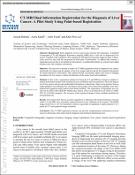Options
CT-MRI Dual Information Registration For The Diagnosis Of Liver Cancer: A Pilot Study Using Point-based Registration.
Journal
Current Medical Imaging Reviews
Date Issued
2022
Author(s)
Aisyah Rahimi
Azira Khalil
Amir Faisal
Khin Wee Lai
DOI
10.2174/1573405617666210825155659
Abstract
Abstract: Background: Early diagnosis of liver cancer may increase life expectancy. Computed Tomography (CT) and Magnetic Resonance Imaging (MRI) play a vital role in diagnosing liver cancer. Together, both modalities offer significant individual and specific diagnosis data to physicians; however, they lack the integration of both types of information. To address this concern, a registration process has to be utilized for the purpose, as multimodal details are crucial in providing the physician with complete information.
Objective: The aim was to present a model of CT-MRI registration used to diagnose liver cancer, specifically for improving the quality of the liver images and provide all the required information for earlier detection of the tumors. This method should concurrently address the issues of imaging procedures for liver cancer to fasten the detection of the tumor from both modalities.
Methods: In this work, a registration scheme for fusing the CT and MRI liver images is studied. A feature point-based method with normalized cross-correlation has been utilized to aid in the diagnosis of liver cancer and provide multimodal information to physicians. Data on ten patients from an online database were obtained. For each dataset, three planar views from both modalities were interpolated and registered using feature point-based methods. The registration of algorithms was carried out by MATLAB (vR2019b, Mathworks, Natick, USA) on an Intel (R) Core (TM) i5-5200U CPU @ 2.20 GHz computer. The accuracy of the registered image is being validated qualitatively and quantitatively.
Results: The results show that an accurate registration is obtained with minimal distance errors by which CT and MRI were accurately registered based on the validation of the experts. The RMSE ranges from 0.02 to 1.01 for translation, which is equivalent in magnitude to approximately 0 to 5 pixels for CT and registered image resolution.
Conclusion: The CT-MRI registration scheme can provide complementary information on liver cancer to physicians, thus improving the diagnosis and treatment planning process.
Objective: The aim was to present a model of CT-MRI registration used to diagnose liver cancer, specifically for improving the quality of the liver images and provide all the required information for earlier detection of the tumors. This method should concurrently address the issues of imaging procedures for liver cancer to fasten the detection of the tumor from both modalities.
Methods: In this work, a registration scheme for fusing the CT and MRI liver images is studied. A feature point-based method with normalized cross-correlation has been utilized to aid in the diagnosis of liver cancer and provide multimodal information to physicians. Data on ten patients from an online database were obtained. For each dataset, three planar views from both modalities were interpolated and registered using feature point-based methods. The registration of algorithms was carried out by MATLAB (vR2019b, Mathworks, Natick, USA) on an Intel (R) Core (TM) i5-5200U CPU @ 2.20 GHz computer. The accuracy of the registered image is being validated qualitatively and quantitatively.
Results: The results show that an accurate registration is obtained with minimal distance errors by which CT and MRI were accurately registered based on the validation of the experts. The RMSE ranges from 0.02 to 1.01 for translation, which is equivalent in magnitude to approximately 0 to 5 pixels for CT and registered image resolution.
Conclusion: The CT-MRI registration scheme can provide complementary information on liver cancer to physicians, thus improving the diagnosis and treatment planning process.
Subjects
File(s)
Loading...
Name
CT-MRI Dual Information Registration for the Diagnosis of Liver Cancer A Pilot Study Using Point-based Registration.pdf
Size
2.03 MB
Format
Adobe PDF
Checksum
(MD5):9260705bcd87f928da0b7f98b76a6999